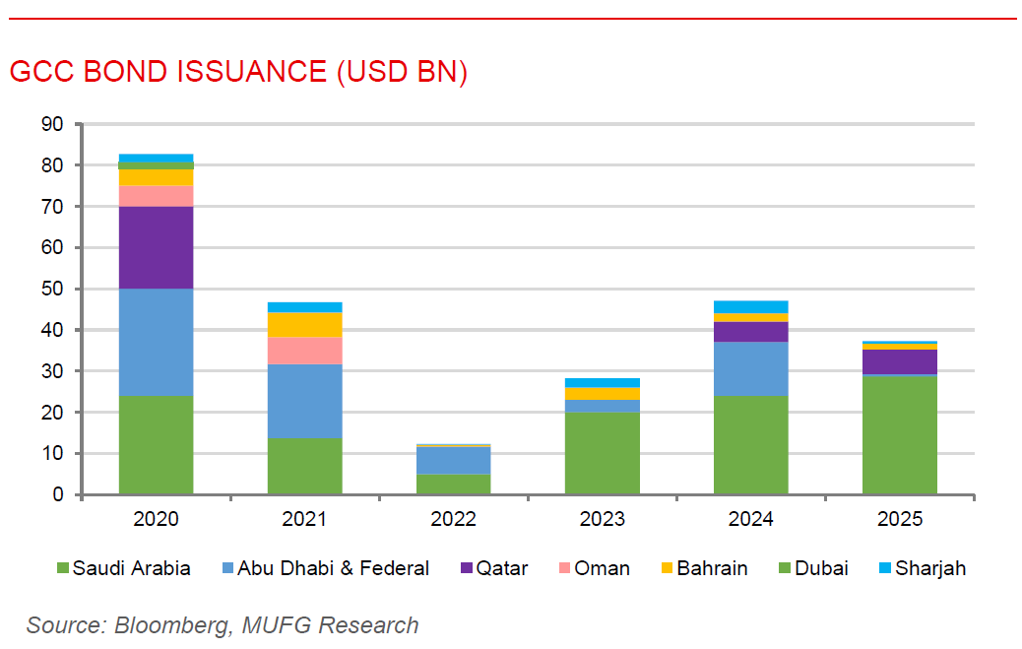To read the full report, please download the PDF above.
Middle East Daily
SOOJIN KIM
Research Analyst
DIFC Branch – Dubai
T: +44(4)387 5031
E: soojin.kim@ae.mufg.jp
MUFG Bank, Ltd. and MUFG Securities plc
A member of MUFG, a global financial group
Middle East Daily
COMMODITIES / ENERGY
Oil prices steady amid inventory decline and Ukraine ceasefire talks. Oil prices held near recent levels, with Brent at around USD66/b and WTI below USD63/b, after data from the American Petroleum Institute suggested a 2.4 million barrel drop in US crude stockpiles, ahead of official figures. Market sentiment remains focused on potential Ukraine-Russia truce talks, as a peace deal ease restrictions on Russian oil exports, though flows to India have already continued despite the conflict. US officials, including Treasury Secretary Scott Bessent, have criticised India’s role in buying Russian crude, with tariff threats adding pressure to trade relations. Despite the near-term support from lower inventories, the longer-term outlook appear bearish, with expectations of a supply glut in 2025 as OPEC+ restores output and trade tensions weigh on demand. Looking ahead, Brent is projected to ease further toward USD65/b by year-end as global inventories build.
Gold eases ahead of Powell’s Jackson Hole address. Gold held near USD3,315/oz, extending a modest 0.5% decline as haven demand softened on renewed efforts to end the Russia-Ukraine war. Investors focus is shifting to Fed Chair Jerome Powell’s Jackson Hole speech, expected to provide clarity on monetary policy, with markets pricing in a potential quarter-point rate cut next month. The outlook remains complicated by stubbornly high inflation, which has tempered some easing expectations, while potential pressure from President Trump for deeper cuts adds further uncertainty. Going forward, gold’s trajectory will hinge on Powell’s policy signals, the balance between inflation risks and easing momentum, and sustained demand from central banks and investors diversifying away from the dollar.
MIDDLE EAST - CREDIT TRADING
End of day comment – 19 August 2025. Very mixed day with a wide range of price/spread moves across names. IG in general was about 2/3bp wider. What stood out was bigger street trades in relation to buy side flows. Especially ADGB and QATAR long end bonds cleared in good size in the morning, leaving bonds offered during the rest of the day, ADGB 54s closing unch/+3bp, QATAR 50s +0.125pt/+2bp. Seen also sellers in quasi names were the compression to sovereign has maybe gone a bit too far, ADNOCM 54s for example was for sale closing -0.375pt/+5bp. In the higher beta space OMAN long end also saw bonds coming out 47s/48s/51s closing -0.5pt/+7bp. Against this GCC financials remained well bid and the +ve risk tone there took FABUH 34s/35s subs and ADCBUH 35s subs another 0.25pt higher. DUGB 50s also continued its squeeze higher closing +0.625pt/-3bp. Overall flows remain light but it looks like there is some street positioning maybe ahead of expected supply. That could still be a couple of weeks ahead of us though and meanwhile market attention will turn to Jackson hole first.
MIDDLE EAST - MACRO / MARKETS
Saudi Arabia taps local market with August sukuk issuance. Saudi Arabia’s National Debt Management Centre raised SAR5.31bn (~USD1.42bn) for August through its riyal-denominated sukuk program, issuing four tranches maturing between 2029 and 2039. The offering was slightly higher than July’s issuance, reflecting tool to diversify financing sources and manage liquidity needs. This latest issuance contribute to Saudi Arabia’s leadership in the GCC’s 2025 primary debt market, accounting for 52.1% of regional bond and sukuk issuance totalling USD47.9bn. The Kingdom has also been actively managing its debt profile through sukuk buybacks and new issuances, while the Public Investment Fund tapped international markets with a USD1.25bn sukuk earlier this year. Going forward, sukuk will remain central to Saudi Arabia’s fiscal and debt strategy as it balances domestic market development with access to international investors.
Israel expands 2025 budget to cover war costs. Israel’s cabinet has approved an upward revision to the 2025 state budget, adding over ILS30bn (USD8.9bn) to fund defence and wartime needs arising from the June conflict with Iran and continued fighting in Gaza. The adjustment, which lifts the fiscal deficit target from 4.9% to 5.2% of GDP, comes just months after the last budget approval and underscores the economic strain of a prolonged 22-month war that has already contributed to a second-quarter contraction. Of the additional allocation, ILS28.9bn will go to defence, pushing military spending to ILS140bn, while ILS1.7bn is reserved for interest costs tied to rising debt. To partially offset the burden, the government will enforce a 3.35% cut across all ministries, while noting that higher than expected revenues have helped limit fiscal slippage. The decision precedes a Bank of Israel meeting, where policymakers are expected to keep rates unchanged for the 13th time as they balance war-driven uncertainty, slowing growth, and inflation still above the 3% target.

